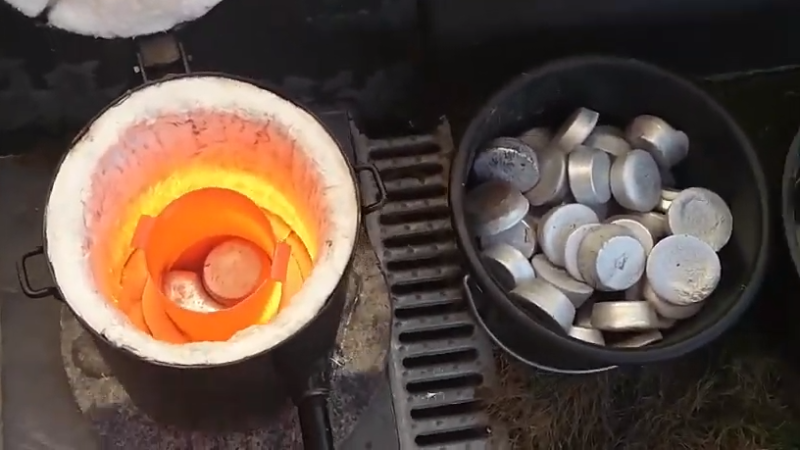 Sand-casting metal parts is a technique that has been around for a very long time, but it can be educational to see the process from start to finish. That’s exactly what [Frederico] shows us with his sand-cast slingshot of his own design, and it’s not bad for what he says is a first try!
Sand-casting metal parts is a technique that has been around for a very long time, but it can be educational to see the process from start to finish. That’s exactly what [Frederico] shows us with his sand-cast slingshot of his own design, and it’s not bad for what he says is a first try!
First, [Frederico] makes a two-part green sand mold of the slingshot body. Green sand is a sand and clay mix, and is only green in the sense that it is wet or “raw” and not further processed. After the mold is made, it’s time to melt aluminum in the propane-powered furnace, and the molten aluminum is then poured into the mold.
After cooling, [Frederico] breaks up the sand to reveal the rough cast object. There is post-processing to do in the form of sprues to cut and some flashing around the seams to remove, but overall it looks to have turned out well. You can watch the whole process in the video, embedded below.
Sand casting is an old technology, but it makes friends easily and isn’t afraid to be seen with new kids on the block like 3D printing.
















Do not use steel as a crucible for aluminum. Molten aluminum will dissolve steel. Its a good way to end up with a boot of molten aluminum. Graphite or clay crucibles are pretty cheap in this size, use them.
And dont cast over concrete, cast over sand or dirt. And yes, I will repeat this every time I see someone making these mistakes.
Didn’t know both of these things, thanks for the heads up.
Aluminum will dissolve steel, but slowly. Welding up a crucible from a section of steel pipe and a disk is cheap and will last a long time – it is unlikely to wear out from hobbyist use. Steel cookware is fine for hobbyist use, and can be had at Salvation Army for next to nothing.
Aluminum can have dissolved gasses. To prevent this, wrap some calcium carbonate (grind up some chalk) in a tinfoil packet and submerge it into the molten Aluminum using a rod. The Aluminum will bubble from released CO2 for a bit, then your melt will have less dissolved gasses.
The most dangerous part of aluminum casting is pouring into the mould. If a drop of water gets inside somewhere, it will flash to steam during the pour and burst out explosively – throwing gobs of molten aluminum everywhere. This is the time to wear your protective clothing. Include something that covers the top of your head (thrown globs of Aluminum, yes?) and tops of your feet.
The 2nd most dangerous part is aluminum spills, which can happen when either a) the mould breaks or burns through, or b) the crucible breaks inside the kiln. Preparing for these events is good technique: design your kiln in sections so that it can be taken apart when cold to easily remove cooled aluminum, and set the mould in something that can catch a full spill. Any steel pan large enough will work, such as a brownie pan.
I have probably 200 melts on a 3mm thick steel crucible and it still hasn’t dissolved. The graphite crucible is nicer, but steel lasts a long time.
Calcium carbonate does okay for degassing. So does baking soda. I’ve been told that potassium chloride, aka low-sodium salt, also works well.
Totally reiterating the don’t pour over concrete.
I pour in a big trunk-sized container of sand: the rest of my greensand. Dig a hole in it and put the mold in there, and then if it cracks (when doing investment) or I float off the cope (when doing greensand) the escaping aluminum has a nice place to run out and cool.
Yeah, concrete is explody. I warn people with pulse power machines likewise, as sending a mega amp through concrete towards the rebar can create quite big craters. Also, all the little bits of missing concrete from the hole turn into little bits of high velocity concrete in the air. Things don’t appreciate finding themselves on the other side of the air. Specific things, that absolutely don’t like little bits of high velocity concrete are windows and helicopters. Lots of other things presumably wouldn’t like it, but as yet remain untested.
This is such a funny coincidence. I’ve spent the last two days reading feverishly on backyard foundries – Alloy Avenue has a free book length PDF called “The Hobbyists Guide to Casting Metal 2nd Ed.”
Hey thanks for the tip!
You’re gonna put you eye out with that..
Heck he darn near just made a cheese slicer! Google up cheese slicer and you could probably buy one and chuck a couple of latex bands on it and have a great Rufus Hussey solid state bean shooter! :)
Only issue I have is ensuring there’s no voids in the arms. I can see pulling back a decent band then having an arm break
Let me show you its features……
Degassing in a home foundry is a myth. Better sprue design and a proper riser though… Martin (Olfoundryman on youtube) explains all about this. In this example the high velosity when pouring down the way too high and too wide sprue makes a turbulent flow of molten metal, thereby sucking in air which makes the porosity in the part.